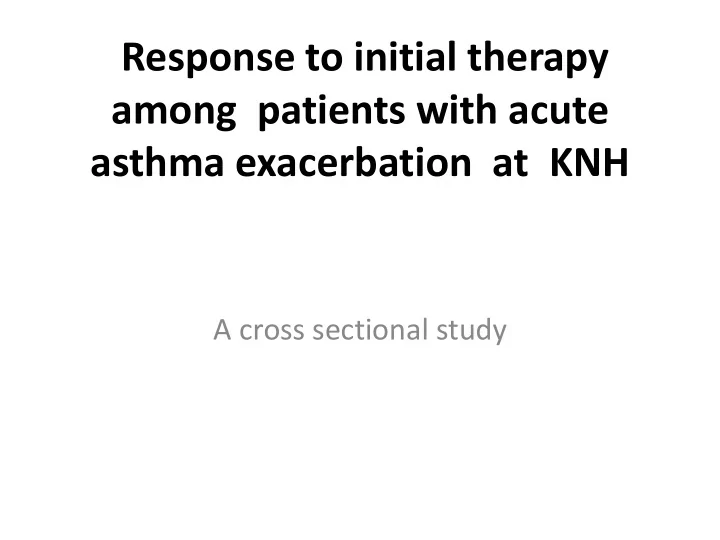

Response to initial therapy among patients with acute asthma exacerbation at KNH A cross sectional study
Author: Lilian Okoth Msc. Co Authors: 1.Wakasiaka Sabina 2.Kirui Angeline 3.Kagema Joan
Background • Asthma is an important NCD with significant morbidity in both children and adult population • Asthma affects about 300 million worldwide • It is estimated that at least 4 million people have asthma in Kenya (KAPTLD,2014)
Problem statement • Asthma is often under diagnosed inadequately assessed and undertreated in most instances • Acute exacerbation is a significant issue in the clinical management of patients with asthma • Frequency of emergency room visits is an important indicator in overall control of asthma
Justification • Treatment response is varied among asthma patients and optimization is key in the management of acute exacerbation • No studies have been done to evaluate response to initial treatment in our emergency setting
Aim /Objective • To establish response to initial treatment among adult patients with acute asthma exacerbations visiting emergency care departments in KNH
Materials and methods • We recruited adult (15 – 60) patients from emergency departments and asthma clinic visit who presented with acute exacerbation • Questionnaire was administered in the treatment room to eligible patients after obtaining consent
Materials &Methods • Information on; Age, sex, occupation , smoking history, level of education, prior bronchodilator use, asthma symptoms and duration of acute symptoms before visiting emergency unit was obtained
• Evaluation of patients was done to include; respiratory parameters i.e PEF, oxygen saturations, before treatment was initiated • This was repeated after a cycle of treatment lasting 20 – 30 minutes • Height and weight were then obtained to calculate BMI
• The prevalence of self reported previously diagnosed diseases – diabetes, hypertension heart conditions, COPD, previous diagnosis of pulmonary TB and allergies was established
• Patients were taken through standard treatment protocols for acute exacerbations i.e beta2 agonists delivered nebulization or inhalation via MDIs • The participants were reviewed by clinicians after each cycle of treatment to assess whether they require repeat treatment. This was selected as best definition of response
• Adequate response as; complete resolution of respiratory symptoms, stable vital signs, O 2 saturation >92%. on room air and PEF >60% of predicted. • Partial response ; minimal resolution of respiratory symptoms, stable vital signs, O 2 saturation >92% on/off oxygen therapy, PEF between 33% and 60% of predicted . • Poor response ; no resolution of symptoms, signs of fatigue or exhaustion,O 2 saturation <92%.
Results • A total of 89 patients with asthma exacerbations were recruited • 66 females (74%) with a mean age of 38.34(SD 10.83) years, between 16 – 57 yrs • Majority had mild/moderate exacerbation (57,64%) at assessment, based on GINA criteria on PEF • Mean BMI was 26.64 (SD.6.7) and 4 (5%) were current smokers while 11(12%) were ex smokers. • The common co morbidities were allergy/acute rhinitis (n=18,21%) followed by hypertension & COPD(n=13,15%) and others (n=10, 10%)
• Regarding use of reliever medication prior to ED visit, 64(72%) used rescue medications before the ED visit • 76 (85%) of patients reported having asthma attack after being in contact with known triggers • Majority 54,(60.7%) of the respondents’ demonstrated poor response, 14,(15.7%) had partial response while only 19,(21.3%) of the cases responded adequately at 1 st treatment cycle
• Regarding symptoms of attack , among the poor responders wheezing, 38(43%) had chest tightness while 19,(21%) were complaining of shortness of breath/dyspnoea and 17(19%) were observed to had chest in drawing • PEFR mean was 66.5(SD 9.2), SPO2 mean 96.3% (SD1.62) after receiving initial therapy in 1 st cycle
Table 1. clinical characteristics of patients Variables n(%) or mean + SD Age (years ) 38.16 + 10.8 Sex , female 66(74.2) BMI, kg/m2 26.64 +6.7 BMI, > 25kg/m2 40 (56) Smoking history Past smoker 11 (12) Current 4 (5) Co morbidities Allergic rhinitis 18(23) Hypertension 13(14) COPD 12 (14) Baseline pulmonary function tests PEFR (% predicted) > 50% 57 (64) Spo2 > 90 65 (73) Use of inhaler prior to ED visit 64( 72)
• Response was significantly associated with BMI as patients with normal weight were to demonstrate adequate response as compared to overweight ( p=0.005, AOR 0.005 - .392) consisted with other studies ( Braido etal,2016, golden et al,2006)
Discussion • Response was not significantly associated with demographics factors or severity of exacerbation or duration of symptoms before presentation. • BMI was associated with response as patients with normal weight were likely to demonstrate adequate response as compared to overweight ( p=0.005 AOR 0.005 - .392) consisted with Braido et,al (2016), golden et al (2006)
Conclusion • Response to initial therapy in acute asthma was observed to be poor • BMI is associated with response to therapy in patients with asthma exacerbation • There is need for case controlled studies to identify other risk factors for poor response in acute asthma
Limitations • Conditions associated with severe exacerbations such as pneumonia and asthma COPD overlap syndrome were not evaluated in this present study • Further studies are needed to evaluate risk factors for poor response and the predictors for future exacerbations in these patients
Implication to practice • Adequate clinical assessment and identification of risk factors to poor response is important , particularly to guide on safe discharge and follow up of patients after the emergency rooms visits
Acknowledgements • The KNH Research & Programs department • Emergency department , and chest clinic of KNH. • My supervisors • My mentors – Dr. Anne Njuguna
Thank you God Bless
Recommend
More recommend